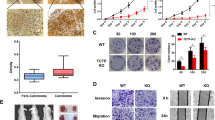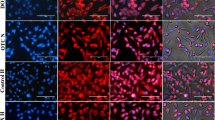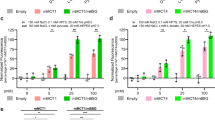Abstract
Translationally controlled tumor protein (TCTP) is a potential target for cancer therapy. It functions as a growth regulating protein implicated in the TSC1–TSC2 –mTOR pathway or a guanine nucleotide dissociation inhibitor for the elongation factors EF1A and EF1Bβ. Accumulating evidence indicates that TCTP also functions as an antiapoptotic protein, through a hitherto unknown mechanism. In keeping with this, we show here that loss of tctp expression in mice leads to increased spontaneous apoptosis during embryogenesis and causes lethality between E6.5 and E9.5. To gain further mechanistic insights into this apoptotic function, we solved and refined the crystal structure of human TCTP at 2.0 Å resolution. We found a structural similarity between the H2–H3 helices of TCTP and the H5–H6 helices of Bax, which have been previously implicated in regulating the mitochondrial membrane permeability during apoptosis. By site-directed mutagenesis we establish the relevance of the H2–H3 helices in TCTP's antiapoptotic function. Finally, we show that TCTP antagonizes apoptosis by inserting into the mitochondrial membrane and inhibiting Bax dimerization. Together, these data therefore further confirm the antiapoptotic role of TCTP in vivo and provide new mechanistic insights into this key function of TCTP.
Similar content being viewed by others
Log in or create a free account to read this content
Gain free access to this article, as well as selected content from this journal and more on nature.com
or
Accession codes
Abbreviations
- TCTP:
-
translationally controlled tumor protein
- MEFs:
-
mouse embryo fibroblasts
- PARP:
-
poly (ADP-ribose) polymerase
- TUNEL:
-
terminal deoxynucleotidyl transferase-mediated dUTP nick end-labeling
- IVT:
-
in vitro translation
- TSC:
-
tuberous sclerosis complex
References
Danial NN, Korsmeyer SJ . Cell death: critical control points. Cell 2004; 116: 205–219.
Graidist P, Phongdara A, Fujise K . Antiapoptotic protein partners fortilin and MCL1 independently protect cells from 5-fluorouracil-induced cytotoxicity. J Biol Chem 2004; 279: 40868–40875.
Li F, Zhang D, Fujise K . Characterization of fortilin, a novel antiapoptotic protein. J Biol Chem 2001; 276: 47542–47549.
Liu H, Peng HW, Cheng YS, Yuan HS, Yang-Yen HF . Stabilization and enhancement of the antiapoptotic activity of mcl-1 by TCTP. Mol Cell Biol 2005; 25: 3117–3126.
Tuynder M, Susini L, Prieur S, Besse S, Fiucci G, Amson R et al. Biological models and genes of tumor reversion: cellular reprogramming through tpt1/TCTP and SIAH-1. Proc Natl Acad Sci USA 2002; 99: 14976–14981.
Yang Y, Yang F, Xiong Z, Yan Y, Wang X, Nishino M et al. An N-terminal region of translationally controlled tumor protein is required for its antiapoptotic activity. Oncogene 2005; 24: 4778–4788.
Zhang D, Li F, Weidner D, Mnjoyan ZH, Fujise K . Physical and functional interaction between myeloid cell leukemia 1 protein (MCL1) and Fortilin. The potential role of MCL1 as a fortilin chaperone. J Biol Chem 2002; 277: 37430–37438.
Chitpatima ST, Makrides S, Bandyopadhyay R, Brawerman G . Nucleotide sequence of a major messenger RNA for a 21 kilodalton polypeptide that is under translational control in mouse tumor cells. Nucleic Acids Res 1988; 16: 2350.
Bommer UA, Lazaris-Karatzas A, De Benedetti A, Nurnberg P, Benndorf R, Bielka H et al. Translational regulation of the mammalian growth-related protein P23: involvement of eIF-4E. Cell Mol Biol Res 1994; 40: 633–641.
Yenofsky R, Cereghini S, Krowczynska A, Brawerman G . Regulation of mRNA utilization in mouse erythroleukemia cells induced to differentiate by exposure to dimethyl sulfoxide. Mol Cell Biol 1983; 3: 1197–1203.
Norbeck J, Blomberg A . Two-dimensional electrophoretic separation of yeast proteins using a non-linear wide range (pH 3-10) immobilized pH gradient in the first dimension; reproducibility and evidence for isoelectric focusing of alkaline (pI >7) proteins. Yeast 1997; 13: 1519–1534.
Hsu YC, Chern JJ, Cai Y, Liu M, Choi KW . Drosophila TCTP is essential for growth and proliferation through regulation of dRheb GTPase. Nature 2007; 445: 785–788.
Gachet Y, Tournier S, Lee M, Lazaris-Karatzas A, Poulton T, Bommer UA . The growth-related, translationally controlled protein P23 has properties of a tubulin binding protein and associates transiently with microtubules during the cell cycle. J Cell Sci 1999; 112 (Part 8): 1257–1271.
Yarm FR . Plk phosphorylation regulates the microtubule-stabilizing protein TCTP. Mol Cell Biol 2002; 22: 6209–6221.
MacDonald SM, Rafnar T, Langdon J, Lichtenstein LM . Molecular identification of an IgE-dependent histamine-releasing factor. Science 1995; 269: 688–690.
Tuynder M, Fiucci G, Prieur S, Lespagnol A, Geant A, Beaucourt S et al. Translationally controlled tumor protein is a target of tumor reversion. Proc Natl Acad Sci USA 2004; 101: 15364–15369.
Petros AM, Olejniczak ET, Fesik SW . Structural biology of the Bcl-2 family of proteins. Biochim Biophys Acta 2004; 1644: 83–94.
Suzuki M, Youle RJ, Tjandra N . Structure of Bax: coregulation of dimer formation and intracellular localization. Cell 2000; 103: 645–654.
Fiucci G, Lespagnol A, Stumptner-Cuvelette P, Beaucourt S, Duflaut D, Susini L et al. Genomic organization and expression of mouse Tpt1 gene. Genomics 2003; 81: 570–578.
Thaw P, Baxter NJ, Hounslow AM, Price C, Waltho JP, Craven CJ . Structure of TCTP reveals unexpected relationship with guanine nucleotide-free chaperones. Nat Struct Biol 2001; 8: 701–704.
Baxter NJ, Thaw P, Higgins LD, Sedelnikova SE, Bramley AL, Price C et al. Backbone NMR assignment of the 19 kDa translationally controlled tumor-associated protein p23fyp from Schizosaccharomyces pombe. J Biomol NMR 2000; 16: 83–84.
Lowther WT, Weissbach H, Etienne F, Brot N, Matthews BW . The mirrored methionine sulfoxide reductases of Neisseria gonorrhoeae pilB. Nat Struct Biol 2002; 9: 348–352.
Elkins P, Bunker A, Cramer WA, Stauffacher CV . A mechanism for toxin insertion into membranes is suggested by the crystal structure of the channel-forming domain of colicin E1. Structure 1997; 5: 443–458.
Minn AJ, Velez P, Schendel SL, Liang H, Muchmore SW, Fesik SW et al. Bcl-x(L) forms an ion channel in synthetic lipid membranes. Nature 1997; 385: 353–357.
Muchmore SW, Sattler M, Liang H, Meadows RP, Harlan JE, Yoon HS et al. X-ray and NMR structure of human Bcl-xL, an inhibitor of programmed cell death. Nature 1996; 381: 335–341.
Schendel SL, Xie Z, Montal MO, Matsuyama S, Montal M et al. Channel formation by antiapoptotic protein Bcl-2. Proc Natl Acad Sci USA 1997; 94: 5113–5118.
Matsuyama S, Schendel SL, Xie Z, Reed JC . Cytoprotection by Bcl-2 requires the pore-forming alpha5 and alpha6 helices. J Biol Chem 2005; 273: 30995–31001.
Cartron PF, Arokium H, Oliver L, Meflah K, Manon S, Vallette FM . Distinct domains control the addressing and the insertion of Bax into mitochondria. J Biol Chem 1998; 280: 10587–10598.
Eskes R, Desagher S, Antonsson B, Martinou JC . Bid induces the oligomerization and insertion of Bax into the outer mitochondrial membrane. Mol Cell Biol 2000; 20: 929–935.
Amzallag N, Passer BJ, Allanic D, Segura E, Thery C, Goud B et al. TSAP6 facilitates the secretion of translationally controlled tumor protein/histamine-releasing factor via a nonclassical pathway. J Biol Chem 2004; 279: 46104–46112.
Amson RB, Nemani M, Roperch JP, Israeli D, Bougueleret L, Le Gall I et al. Isolation of 10 differentially expressed cDNAs in p53-induced apoptosis: activation of the vertebrate homologue of the drosophila seven in absentia gene. Proc Natl Acad Sci USA 1996; 93: 3953–3957.
Cans C, Passer BJ, Shalak V, Nancy-Portebois V, Crible V, Amzallag N et al. Translationally controlled tumor protein acts as a guanine nucleotide dissociation inhibitor on the translation elongation factor eEF1A. Proc Natl Acad Sci USA 2003; 100: 13892–13897.
Nuoffer C, Wu SK, Dascher C, Balch WE . Mss4 does not function as an exchange factor for Rab in endoplasmic reticulum to Golgi transport. Mol Biol Cell 1997; 8: 1305–1316.
Chen SH, Wu PS, Chou CH, Yan YT, Liu H, Weng SY et al. A knockout mouse approach reveals that TCTP functions as an essential factor for cell proliferation and survival in a tissue- or cell type-specific manner. Mol Biol Cell 2007; 18: 2525–2532.
Otwinowski Z, Minor W . Processing of X-ray diffraction data collected in oscillation mode. Methods Enzymol 1997; 276: 307–326.
Collaborative Computational Project. The CCP4 suite: programs for protein crystallography. Acta Crystallogr D Biol Crystallogr 1994; 50: 760–763.
Brunger AT, Adams PD, Clore GM, DeLano WL, Gros P, Grosse-Kunstleve RW et al. Crystallography & NMR system: A new software suite for macromolecular structure determination. Acta Crystallogr D Biol Crystallogr 1998; 54 (Part 5): 905–921.
Kleywegt GJ, Jones TA . Efficient rebuilding of protein structures. Acta Cryst 1996; D52: 829–832.
Laskowski RA, Mac Arthur MW, Moss DS, Thornton JM . PROCHECK: a program to check the stereochemical quality of protein structure. J Appl Crystallogr 1993; 26: 283–291.
Wodak SJ, Pontius J, Vaguine A, Richelle J . Validating Protein Structures. From Consistency Checking to Quality Assessment. SERC Daresbury Laboratory: Warrington, UK, 1995.
Acknowledgements
This study is part of the PhD thesis of Dominique Duflaut (Université Paris XI) and Alexandra Lespagnol (Université Paris VII). We thank the staff of the European Synchrotron Radiation Facility beam line ID14-1 for use of their synchrotron instrumentation and help during data collection. We are in debt to Pierre Chambon for his longstanding support and grateful to Tania Sorg and Daniel Metzger for their help and advice in the generation of the tctp knockout mice. CB is supported by a grant from the Belgian Foundation for Cancer Research.
Author information
Authors and Affiliations
Corresponding author
Additional information
Edited by KH Vousden
Competing interest statement
The authors declare that they have no competing financial interests.
Supplementary Information accompanies the paper on Cell Death and Differentiation website (http://www.nature.com/cdd)
Supplementary information
Rights and permissions
About this article
Cite this article
Susini, L., Besse, S., Duflaut, D. et al. TCTP protects from apoptotic cell death by antagonizing bax function. Cell Death Differ 15, 1211–1220 (2008). https://doi.org/10.1038/cdd.2008.18
Received:
Revised:
Accepted:
Published:
Issue date:
DOI: https://doi.org/10.1038/cdd.2008.18
Keywords
This article is cited by
-
Topoisomerase II is regulated by translationally controlled tumor protein for cell survival during organ growth in Drosophila
Cell Death & Disease (2021)
-
TCTP protein degradation by targeting mTORC1 and signaling through S6K, Akt, and Plk1 sensitizes lung cancer cells to DNA-damaging drugs
Scientific Reports (2021)
-
Flexible loop and helix 2 domains of TCTP are the functional domains of dimerized TCTP
Scientific Reports (2020)
-
Translationally controlled tumor protein (TCTP) plays a pivotal role in cardiomyocyte survival through a Bnip3-dependent mechanism
Cell Death & Disease (2019)
-
Blood feeding tsetse flies as hosts and vectors of mammals-pre-adapted African Trypanosoma: current and expected research directions
BMC Microbiology (2018)



